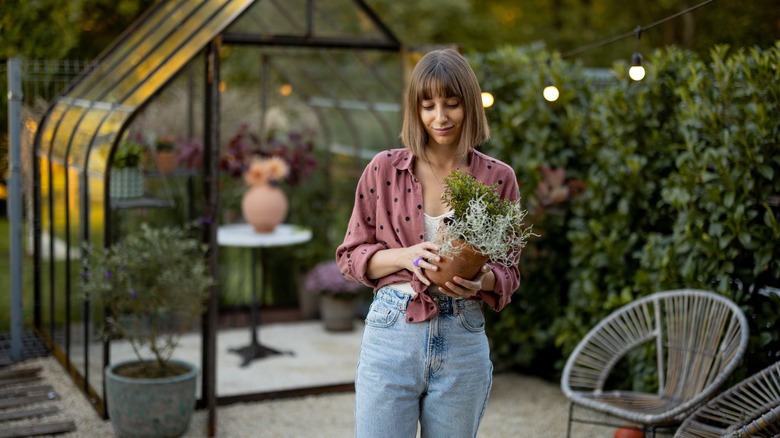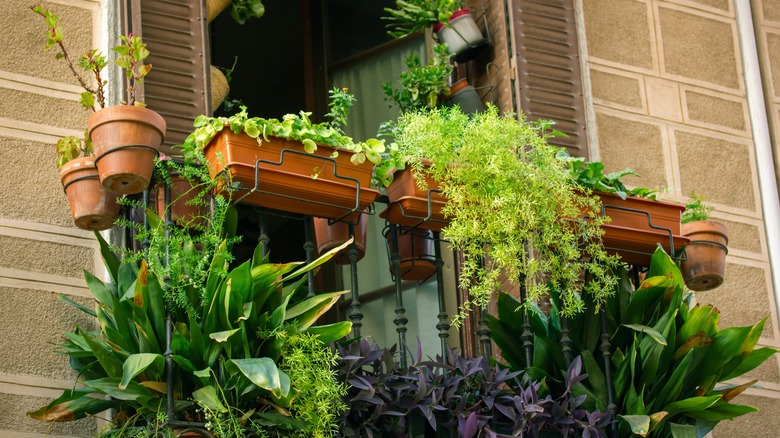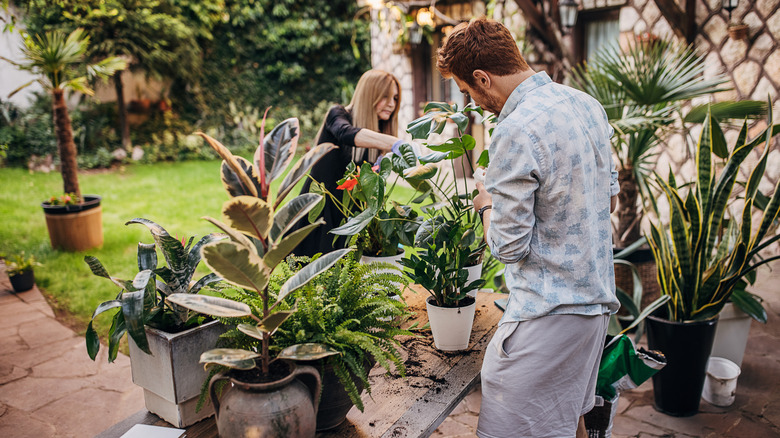The Benefits Of Moving Your Houseplants Outdoors In The Summertime
Letting our poor house-bound potted plants soak in the sun and feel the warm breeze sounds as refreshing to us as it is for our plants. When summer temps have settled in, moving your houseplants outdoors for the season has genuine benefits. The plants will love it, and you might even find that there's less maintenance for you to do. Sun, rainwater, and wind are a strength-building cocktail that can keep your houseplants healthy if you do it right. And you can enjoy a ready-made outdoor garden by putting your houseplants on a sunny balcony or patio.
After nurturing our greenery for months indoors, the last thing we want is to endanger our potted friends when we give them a change of scenery. Caring for your houseplants outdoors in summer isn't difficult, but there are some important factors to consider for this effort to be worthwhile. By heeding a few guidelines, a season outside can be a tonic for your indoor plants while they pretty up your outdoor space.
What are the benefits of moving plants outdoors?
Just like for many other living things, the fresh air, warmth, and sunlight of summer are the ingredients for growth spurts. By moving houseplants outdoors during this time, they can take advantage of long, sun-filled days and breezes that encourage new growth. Even the necessary step of acclimating your plants, as you'll read further on, can strengthen their roots and cell walls.
If you live in a humid area, the extra moisture plants can get from the air can give them a boost. Indoors, air conditioning removes a lot of water from the air. Putting houseplants plants out in the rain can help cut down on time you dedicate to plant care and expose them to extra nutrients found in rainwater. Having your plants on a deck or patio makes it easier to water them quickly with a hose during drier times, as well.
The rains and winds can do wonders for your plants' leaf health as well. Dust and grime accumulate on houseplants' leaves while they live indoors. A shower from above and some nice air currents give plants a bath. Removing buildup from plant leaves lets plants photosynthesize more easily, which helps them fight disease.
What are some guidelines for keeping houseplants outdoors?
The point of taking our plants outdoors for a few months is to boost their health. Take steps to let plants get the most out of their new space and not come away worse off than they were before. Temperatures, moisture, and light are three of the biggest factors to consider before ushering your houseplants into the great outdoors.
Houseplants are used to consistent temperatures; in order to thrive outdoors, they need to acclimate. When daily low temperatures are 50 degrees Fahrenheit or warmer for regular periods of time, begin hardening your plants. This entails taking plants outside for gradually longer chunks of time — eventually overnight — to acclimate them to all the variables they'll experience outdoors. This will prevent plants from feeling too much stress during a change of environment. When finding an outdoor spot for each plant, know that many houseplants are native to shady of tropical forests and won't do best in full sun. Look at the specific care instructions for your plants to see what their sunlight needs are.
The lovely growth spurts your plants could experience may also require repotting them early in the season. Some plants may bulk up so much that they outgrow their pots. You should upgrade your pots by no more than one or two sizes. Consider transplanting them to heavier pots like ceramics or wood to give them a strong support against wind as well as growth.


